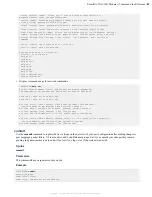
SmartNA-X 1G/10G Modular | SNMP |
79
SmartNA-X
™
1G/10G User Guide 1.4
©
2015 Network Critical Solutions Limited
• Port link-down state (linkDown)
• Data rate above high threshold (nctapNotifyXSTrafficOver)
• Data rate below low threshold (nctapNotifyXSTrafficUnder
• TAP module inserted or removed (nctapNotifyCard)
• Failed login attempt (ncUnauthorisedAccess)
3.
Click
Review/apply
and review pending changes. To apply these changes to the system, click
Apply changes
or click
'
X
' to cancel.
Configuring notification hosts
1.
Click on the chassis and select the
SNMP
tab.
2.
Click
Configure notification hosts
.
3.
To add a new host, click
Add new notification host
, or to edit an existing host click the icon that is next to the
required host. The
Add/Edit notification host
dialog displays (see the figure below).
4.
Enter or edit details for the notification host:
•
Destination
– Enter a location for the notification host in the following format:
{protocol}:]{host}[:{port}]
where
protocol
can be
udp
or
udp6
;
host
can be a hostname or an IPv4 or IPv6 address;
port
is the UDP port on the host
•
SNMP version
– Choose whether notifications are to be sent using SNMP v1, v2c or v3.
•
Notification type
– Specify whether notifications may be sent as traps or (where supported) informs.
•
Credentials
– Enter security credentials for the Manager. For SNMP v1 or v2c it is the community string. For
SNMP v3 it is an existing local user (for traps) or remote user (for informs).
•
Engine ID
– Specify the corresponding engine ID where a remote user is specified
5.
Click
Add host
to finish setting up the notification host.
6.
Click
Review/apply
and review pending changes. To apply these changes to the system, click
Apply changes
or click
'
X
' to cancel.
Figure 66: The SNMP Add/Edit notification host dialog
Defining SNMPv1/v2 communities
Access rights in SNMPv1 and SNMPv2 are managed by defining communities in the
Configure communities
dialog,
which is available after clicking
Traditional access control
. The community name is a type of shared password between
the SNMP management station and the device. It is used to authenticate the SNMP management station.
Communities are only defined in SNMPv1 and v2 because SNMP v3 works with users instead of communities. The users
belong to groups that have access rights assigned to them.






























